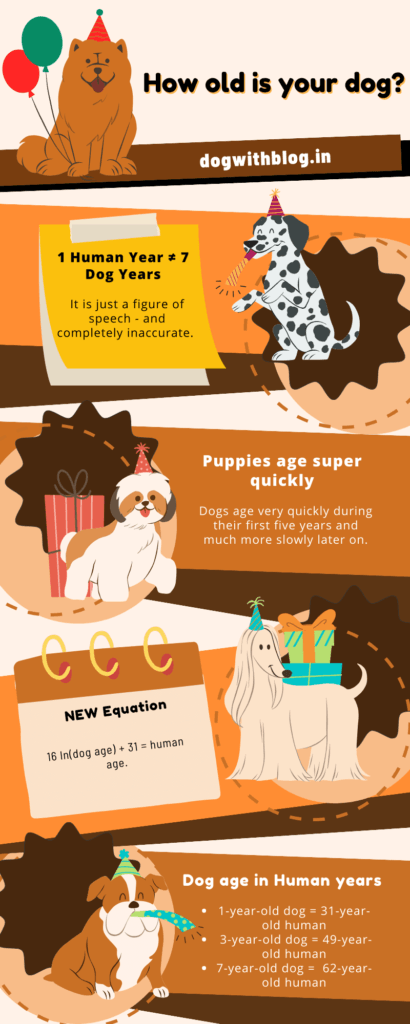
In a world where time races by, our canine companions are the loyal guardians of moments that matter. Their wagging tails and soulful eyes have a remarkable ability to slow down the clock and remind us of life’s simplest joys. But what if we told you that the “dog years” concept, a widely accepted measure of canine age, might be a myth?
Let’s unravel the mysteries of canine aging and reveal insights that could change the way you see your beloved furry friends. Welcome to a tale of time, truth, and the enduring bonds we share with our canine confidants.
Cracking the Code of Dog Years
Why 1 Human Year ≠ 7 Dog Years
Tracing the Origins of the Myth: On average, humans live around 7 times longer than dogs. As a way to anthropomorphise their pets, this became an over-simplified way of working out how “old” their dog is. It stems from people going “Well, Humans live 70 years, and dogs live 10 years, so…”
The Flawed Logic Behind the Equation
But “every dog year is 7 human years” is just a figure of speech – and completely inaccurate. And as you can tell, both those numbers are pretty arbitrary. Human and dog life-spans have a large range to them. A better approach is to link a dog’s age and development to humans. But remember, it’s not a straightforward one-size-fits-all comparison and can vary between individuals.
A more scientific approach to the age equation would take variables like metabolism and age related issues. Dogs age rapidly in their first five years but then age at a slower pace as they grow older.
How old is your dog in Human Years?
To understand how dogs and humans age in similar ways, scientists, led by Professor Trey Ideker from the University of California, San Diego, studied 104 Labrador retrievers. These Labradors ranged from young puppies to elderly 16-year-old dogs.
They delved into the intricate world of canine genetics, and uncovered a remarkable truth about how dogs age. Their findings highlight that by the a dog reaches one year, at a molecular level, their age is more comparable to that of a 30-year-old human.
In their study, researchers compared dog DNA data with human information and devised a new equation to determine a dog’s age in human terms: 16 ln(dog age) + 31 = human age. ‘ln’ refers to natural logarithm.
The Dog years to Human years equation exhibits the following results:
– A 1-year-old dog is akin to a 31-year-old human.
– A 3-year-old dog aligns with a 49-year-old human.
– A 7-year-old dog is equal to a 62-year-old human. (This may be the age where dogs are considered as seniors)
– By age 8, a dog’s aging slows, making them like a 64-year-old human.
According to this equation, the average 12-year Labrador lifespan corresponds to a human living to about 70.
While variations may exist based on dog breeds, the overall aging pattern remains consistent.
The dogs reach adulthood in about 6 months (which is true, since they are capable of reproducing about that age) and fully grown to the peak of their physical abilities at 1 year old.
It may seem super fast growth, and it is, but remember, it is a logarithmic scale, so the older the dog gets, the slower and more close to human growth it becomes.

What can you do to help your dogs live a long, happy, healthy life?
Old equation or new, you wish to extend our furry friend’s lifespan, irrespective of the mathematics behind it. When it comes to extending your dog’s joyful journey through life, you hold the keys. Learn how to provide your beloved furry companion with the happiest, healthiest, and longest life possible.
As your furry friend ages, regular veterinary checkups become even more crucial. Senior dogs are more prone to developing health issues like arthritis, cognitive decline, and cancer. Twice-yearly checkups allow vets to detect issues early, often leading to better treatment outcomes and improved quality of life.
Signs that your senior dog might need immediate attention include:
- Changes in behavior
- Limping
- Excessive thirst or urination
These could indicate underlying health problems that require prompt veterinary care.
Common health concerns in senior dogs:
- Obesity: Regular exercise and a senior-friendly diet can help manage weight and prevent related health complications.
- Osteoarthritis: While age-related joint pain is common, medication and gentle exercise like swimming can improve mobility and comfort.
- Cognitive decline: Mental stimulation through games and activities can help slow down cognitive decline and maintain your dog’s well-being.
- Hearing and vision loss: While these can be gradual, providing a safe and familiar environment with minimal changes can help your senior dog adapt.
- Urinary incontinence: Consult your vet about treatment options, as it could be linked to weakened bladder muscles or other health issues.
- Cancer: Early detection is crucial, so be aware of any unusual lumps or bumps and schedule a vet visit promptly.
Exercise remains vital for senior dogs, even if their energy levels decrease. Low-impact activities like walks and swimming promote weight management, muscle strength, and mental stimulation, all contributing to a healthier and happier senior life. Remember to tailor the exercise routine to your dog’s individual needs and abilities, and always prioritize their comfort and well-being.
By being proactive and attentive to your senior dog’s health, you can ensure they enjoy their golden years to the fullest.
1. Opt for Premium Nutrition: Choose high-quality dog food, and remember, moderation is key – lean dogs are often healthier ones.
2. Prioritize Preventative Care: Ensure your pet receives essential preventative healthcare, including flea and tick control, heartworm prevention, and up-to-date vaccinations.
3. Exercise Wisely: Regular aerobic exercise is crucial. Tailor the length of your walks to your dog’s stamina and age, avoiding excessive strain on puppies’ developing joints.
Also See: How to exercise with your dog?
4. Build Strength and Balance: Incorporate exercises that enhance balance and core muscle development, especially as your dog matures.
5. Annual Wellness Check-ups: Schedule yearly wellness visits with your veterinarian. They have the expertise to detect subtle health issues that might go unnoticed. As a dog owner, your vet is your greatest ally in ensuring your pet’s well-being.
Remember that every moment with your furry friend is a treasure. By understanding the science behind their aging and embracing the tips shared here, you’ll not only unlock the secrets to a longer, healthier life for your dog but also deepen the bond you share.
Connect with Dog with Blog on Facebook Instagram Twitter